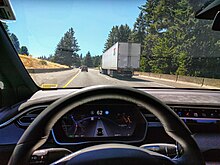| Advanced driver-assistance systems | |
|---|---|
 | |
| Industry | Automotive |
| Application | Automobile |
| Components | Sensors (typically cameras, proximity, and/or lidar), microprocessors, software, and actuators |
| Examples | Adaptive cruise control Lane centering Hands-free driving |
Advanced driver-assistance systems (ADAS) are technologies that assist drivers with the safe operation of a vehicle. Through a human-machine interface, ADAS increase car and road safety. ADAS use automated technology, such as sensors and cameras, to detect nearby obstacles or driver errors, and respond accordingly. ADAS can enable various levels of autonomous driving.
As most road crashes occur due to human error,[2] ADAS are developed to automate, adapt, and enhance vehicle technology for safety and better driving. ADAS are proven to reduce road fatalities by minimizing human error.[3] Safety features are designed to avoid crashes and collisions by offering technologies that alert the driver to problems, implementing safeguards, and taking control of the vehicle if necessary. ADAS may provide adaptive cruise control, assist in avoiding collisions, alert drivers to possible obstacles, warn of lane departure, assist in lane centering, incorporate satellite navigation, provide traffic warnings, provide navigational assistance through smartphones, automate lighting, or provide other features.[3] According to the national crash database in the USA, Forward Collision Prevention systems have the potential to reduce crashes by 29%. Similarly, Lane Keeping Assistance is shown to offer a reduction potential of 19%, while Blind Zone Detection could decrease crash incidents by 9%.[4]
According to a 2021 research report from Canalys, approximately 33 percent of new vehicles sold in the United States, Europe, Japan, and China had ADAS. The firm also predicted that fifty percent of all automobiles on the road by the year 2030 would be ADAS-enabled.[5]
- ^ Epstein, Zach (2016-07-21). "Tesla Autopilot Crash Avoidance Model S Autopilot saves man's life". BGR. Retrieved 2016-08-26.
- ^ Brookhuis, Karel A.; de Waard, Dick; Janssen, Wiel H. (2001-06-01). "Behavioural impacts of Advanced Driver Assistance Systems–An Overview". European Journal of Transport and Infrastructure Research. 1 (3). doi:10.18757/ejtir.2001.1.3.3667. S2CID 38666182.
- ^ a b Abdul Hamid, Umar Zakir; Ahmad Zakuan, Fakhrul Razi; Zulkepli, Khairul; Azmi, Muhammad Zulfaqar; Zamzuri, Hairi; Abdul Rahman, Mohd Azizi; Zakaria, Muhammad (2017-12-01). "Autonomous emergency braking system with potential field risk assessment for frontal collision mitigation". 2017 IEEE Conference on Systems, Process and Control (ICSPC). pp. 71–76. doi:10.1109/SPC.2017.8313024. ISBN 978-1-5386-0386-4. S2CID 3882240.
- ^ Aleksa, Michael; Schaub, Andrea; Erdelean, Isabela; Wittmann, Stephan; Soteropoulos, Aggelos; Fürdös, Alexander (2024-06-27). "Impact analysis of Advanced Driver Assistance Systems (ADAS) regarding road safety – computing reduction potentials". European Transport Research Review. 16 (1): 39. doi:10.1186/s12544-024-00654-0. ISSN 1866-8887.
- ^ Nagpal, Raj Kumar; Cohen, Edo (2022-05-18). "Automotive electronics revolution". Embedded. AspenCore. Retrieved 2022-05-19.